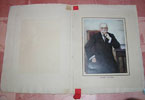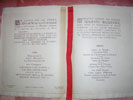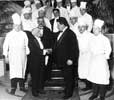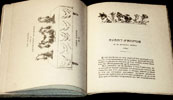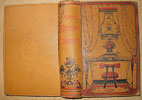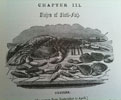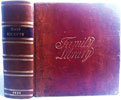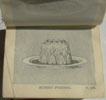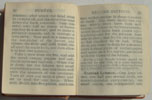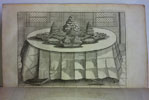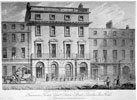The Cafe Royal Story
A Living Legend EDITED BY Leslie Frewin WITH A FOREWARD BY Graham Greene LONDON: HUTCHINSON BENHAM.
FIRST EDITION. 1963. Large 4to. Paste-down and end-paper with sepia photograph. [1] Half title. [2] Frontispiece copy of a Charles Ginner painting of the Cafe Royal. Title page in black with a large ornamental decoration in red. Verso with printers info. 1p Introduction. [1] 2p Contents. 9-10 Paste-down and end-paper with sepia photograph. With numerous photographs and illustrations in-text, some full page. Fully bound in cream cloth. Spine with red writing and boards with fine illustration in red and black. All in excellent condition; as new, protected by a plastic wrapper. Also enclosed is a Christmas Luncheon menu for December 11th 1964, for 'The Horticultural Press Club'. Cream coloured with black text, in fine condition.
- The Cafe Royal, established in 1865, boasted its famously opulent Grill Room, considered one of London's finest dining rooms; the great Empire and Napoleon suite, elegantly lit by chandeliers made of Venetian glass, was favoured by those looking for a memorable party venue. For more than a century after it was built on Regent Street by a Parisian wine merchant, the rich and famous would flock there to eat, drink, dance and be merry. The Grill Room was also once its most notorious. It was there that the Marquess of Queensberry spotted his son, Lord Alfred Douglas (aka Bosie), lunching with Oscar Wilde "in the most loathsome and disgusting relationship". He later wrote a furious letter to his son, threatening to shoot Wilde on sight, to which Bosie insouciantly telegrammed back: "What a funny little man you are." The Café Royal was a favourite haunt of Wilde, who had a famous absinthe hallucination there when he thought the waiter, who was stacking chairs, was in fact watering the floor, covered in tulips, with a watering can. Other famous Patrons included Rudyard Kipling, Noel Coward, Sir Winston Churchill, Cary Grant, Brigitte Bardot, Elizabeth Taylor, Vitrginia Woolf, Mick Jagger, Princess Diana, Margaret Thatcher and Muhammad Ali. On 2oth January 2009, the curtains came down, literally, in the Café Royal. After 143 illustrious years, the fixtures, fittings and all the equipment of this venerable London institution was being put under the hammer of Bonhams the Auctioneers, after the Crown Estate decided to redevelop the site at that end of Regent Street. Had it spent its life almost anywhere else, the slightly battered silver serving trolley with the fickle steering would have barely raised an eyebrow in the dining room, let alone a flurry of paddles in an auction house. But this piece of functional furniture has had an extraordinary history. Amazingly, the electroplated trolley sold for £12,000 in the Everything-Must-Go sale. By the end of the two-hour auction, more than £200,000 had been raised. All 110 lots had been sold, some for as much as 10 times their asking price. An early 20th century Venetian chandelier adorned with 20 lights was the most expensive lot, going for £15,600, twice its guide price. Lot 93, a pair of late 19th century oak coopered barrels long drained of the alcohol they once contained, went for £8,400, almost five times their estimate. A number of pictures by artists so undistinguished their names weren't even listed in Bonhams' brochure sold for thousands of pounds – purely, it seemed, because they depicted scenes from the Cafe Royal, and had once hung in the venue's famously opulent chambers. One, a scene of the grill room filled with men in top hats and tails, sold for £4,800, despite Bonhams estimating its value at between £200 and £300. One buyer who bid purely for sentimental reasons was Susan Hughes, an antique dealer from Weybridge, who snapped up one of the auction's most curious lots. She ended up paying £4,200 for what the brochure, giving a guide price of £100-£200, described as "a 19th century electroplated duck press". It was in fact the press for ‘Canard a’la Presse’ – for more than a century the celebrated speciality of Paris’s grandest restaurant, La Tour d’Argent. This niche piece of equipment, which resembled a large grapefruit press, is used to squeeze out the juices of a freshly killed and roasted duck carcass, which in turn are used to thicken the duck jus. Hughes's father, Eric Hartwell (see image #3 below) was chief executive of the Forte catering and hotel empire, which bought the Cafe Royal 1954. "I spent much of my childhood playing in the Cafe Royal, and my father was very proud of the duck press," she said. As her husband loaded the contraption into the back of their car, he admitted that though the couple were delighted to own this piece of history, they wouldn't be using it. "We're both vegetarians," he said. So that is the final chapter that should be in the book. Overall it is a fascinating story of a grand eating establishment that was on a par with The Savoy, Claridges, The Ritz et al. One will never see the same again. This interesting volume is a meal, a fine wine and a waltz thro’ a different age with a hearty dose of gossip thrown in to round of a memorable time.


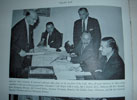

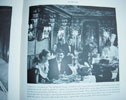

click on image to enlarge

Modern category
ref number:
11111 







